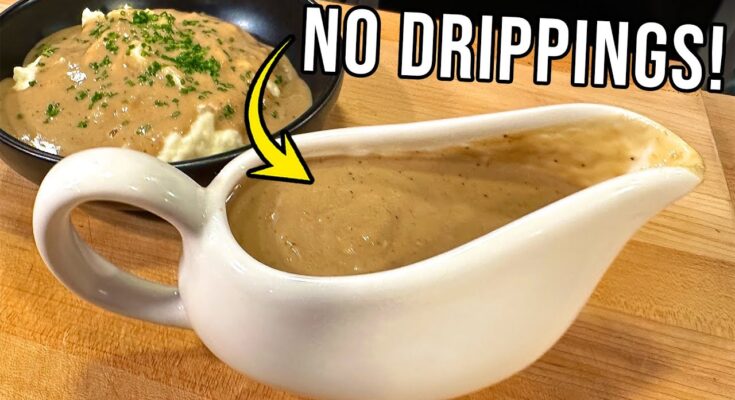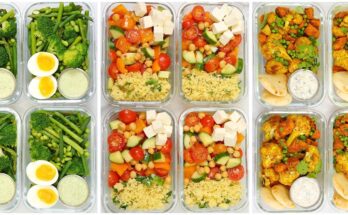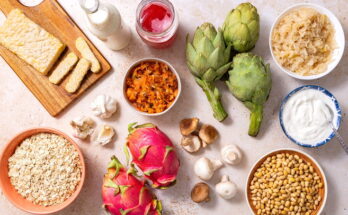Easy Gravy Recipe: Gravy is the soul of comfort food. You know that rich, savory, golden or dark brown sauce that you pour generously over mashed potatoes, meat, or even rice? Yep, that’s gravy. At its core, it’s a simple combination of fat, flour, and broth—but don’t let its simplicity fool you. Gravy has the magical ability to tie an entire meal together with its creamy, umami-packed goodness.
Originating from traditional European cooking, gravy has become a staple in cuisines all over the world. Whether it’s Thanksgiving dinner in the U.S., Sunday roast in the UK, or a meatloaf dinner in grandma’s kitchen, gravy plays a starring role. And the best part? You don’t have to be a professional chef to make it. With the right ingredients and some basic techniques, anyone can whip up homemade gravy that tastes like it’s been simmering in a restaurant kitchen.
Why Homemade Gravy Tastes Better
There’s just no comparison between homemade and store-bought gravy. Pre-made gravies are often loaded with preservatives, artificial flavors, and sodium that can make them taste like salty paste. Homemade gravy, on the other hand, is fresher, more flavorful, and customizable to your liking.
When you make it yourself, you control the richness, the texture, the salt level, and even the ingredients. Want it thicker? Add a bit more flour. Prefer a deeper flavor? Use beef drippings instead of chicken broth. That level of control is what makes homemade gravy such a game-changer—and honestly, once you try it, you won’t want to go back.
Ingredients You’ll Need
Basic Ingredients for Classic Gravy
Let’s keep things simple to start. Here are the core ingredients you need to make a classic, foolproof gravy:
- Fat or drippings (from roasted meat like turkey, chicken, or beef)
- All-purpose flour (for thickening)
- Broth or stock (chicken, beef, or vegetable)
- Salt and pepper (to season)
That’s it. Just four simple ingredients, and you’ve got yourself a silky, rich gravy. The beauty of this base recipe is its versatility. You can build on it, tweak it, and make it your own, depending on what you’re cooking and what flavors you love.
Now, let’s take a closer look at how these ingredients work together:
- Fat or drippings – This gives your gravy depth and richness. The browned bits at the bottom of a roasting pan? That’s liquid gold.
- Flour – This is your thickener. When cooked with the fat, it forms a roux, which is the foundation of almost all gravies.
- Broth – This is the liquid that turns your roux into a sauce. Homemade broth will obviously taste better, but store-bought works fine in a pinch.
- Seasoning – You’ll want to taste as you go. The broth may already be salty, so don’t go overboard with the salt until the end.
Optional Add-Ins to Enhance Flavor
Want to take your gravy from great to amazing? Try adding these extras:
- Onions or garlic – Sautéed in the fat for a rich, aromatic base.
- Herbs – Thyme, rosemary, sage, or parsley add earthy flavor.
- Wine or cream – A splash of dry white wine or a swirl of heavy cream can elevate the taste.
- Soy sauce or Worcestershire sauce – These add umami and complexity.
- Mushrooms – For a hearty, earthy vegetarian twist.
These are not required, but if you’ve got them on hand, don’t be afraid to experiment.
Tools and Equipment Required
Must-Have Kitchen Tools for Gravy Making
Gravy doesn’t demand fancy tools, but having the right equipment makes the process smoother. Here’s what you’ll need:
- Medium saucepan or skillet – A good non-stick or stainless-steel pan is ideal for making the roux and simmering the gravy.
- Whisk – This is essential. A whisk helps break up lumps and ensures your gravy is smooth and creamy.
- Measuring cups and spoons – For precision, especially when you’re just starting out.
- Strainer or sieve (optional) – If you want a velvety-smooth finish, strain your gravy before serving.
- Ladle – For serving without making a mess.
If you’re making gravy from meat drippings, you’ll also need:
- Roasting pan – To catch all those delicious juices.
- Fat separator (optional) – Helps remove excess fat if you want a leaner gravy.
Trust me, with these tools, you’re fully equipped to turn out a gravy that’ll have people licking their plates.
Preparing for the Gravy
Tips Before You Start Cooking
Before you even light the stove, a little prep goes a long way. Gravy might seem quick, but it moves fast once you start. Here’s how to set yourself up for success:
- Read through the whole recipe – Know your steps so nothing catches you off guard.
- Have all your ingredients measured and ready – This is known as “mise en place” in culinary terms.
- Warm your broth – Adding cold broth to a hot roux can cause clumping. Warming it up keeps the consistency smooth.
- Keep whisking tools within arm’s reach – Timing is everything with gravy, and you don’t want to scramble for a whisk mid-pour.
How to Prepare Your Broth or Drippings
Using pan drippings? Here’s how to make the most of them:
- After roasting meat, pour the drippings into a bowl or measuring cup.
- Let it sit for a few minutes so the fat rises to the top.
- Skim off some of the fat if there’s too much, but leave enough to make your roux.
- Use the remaining flavorful liquid (juices and browned bits) as your broth base.
No drippings? No problem. Just warm up store-bought broth or stock. You can even boost its flavor with a splash of soy sauce or a bouillon cube.
Step-by-Step Easy Gravy Recipe
Step 1 – Make a Roux
Making a roux is the heart of any good gravy. It might sound fancy, but it’s incredibly easy. All it means is combining fat and flour over heat until they form a smooth, golden paste. This is your thickener, and it’s what gives gravy its rich, creamy body.
Here’s how to do it:
- Place a saucepan or skillet over medium heat.
- Add about 2 tablespoons of fat (butter, pan drippings, or oil).
- Once the fat is melted and hot, sprinkle in 2 tablespoons of all-purpose flour.
- Whisk constantly. You’ll see the mixture start to bubble and thicken—keep whisking!
- Let it cook for about 2–3 minutes until the roux turns a light golden brown. This helps eliminate the raw flour taste and adds a deeper flavor to your gravy.
Don’t rush this step. A well-cooked roux is the foundation for a flavorful, lump-free gravy. Keep whisking and watch for that nutty aroma—that’s your cue that it’s ready for the next step.
Step 2 – Add Liquid Gradually
Once your roux is cooked and golden, it’s time to turn it into gravy by slowly adding your broth or drippings.
- Take your warm broth and gradually pour it into the roux, about ½ cup at a time.
- Whisk constantly as you pour to prevent lumps from forming.
- Once the mixture starts to loosen and smooth out, you can pour in the rest of the liquid more quickly.
- A standard ratio is about 2 cups of liquid for every 2 tablespoons of flour, but you can adjust this depending on how thick or thin you want your gravy.
The key here is patience and motion. Don’t dump the broth in all at once. Pour, whisk, pour, whisk. This step is where your gravy starts to take shape, and smoothness is everything.
Step 3 – Simmer and Thicken
Now that your liquid is fully incorporated, it’s time to simmer the gravy to let it thicken and develop flavor.
- Bring the mixture to a gentle simmer over medium heat.
- Keep whisking occasionally to prevent it from sticking to the bottom.
- Within 5–10 minutes, you’ll notice the gravy thickening. If it gets too thick, just add a splash of broth or water.
- If it’s too thin, let it simmer a bit longer or stir in a tiny slurry (a mix of flour and water).
Watch for the consistency you like. Some folks love thick, clingy gravy, while others prefer a lighter, pourable sauce. Either way, you’re in control.
Step 4 – Season to Taste
You might think it’s done once it thickens, but hold up—now it’s time to make it sing with flavor.
- Taste your gravy first. The broth and drippings might already bring in salt, so don’t go seasoning blindly.
- Add salt and pepper to taste.
- For extra depth, stir in a splash of Worcestershire sauce, soy sauce, or even a tiny dash of vinegar to brighten things up.
- If you’re feeling fancy, add a bit of cream or a touch of wine for an elevated flavor.
This step is all about customizing your gravy to match your meal and your taste buds. Don’t be afraid to get creative here.
Step 5 – Strain and Serve
This final step is optional but can make a big difference if you’re going for restaurant-level smoothness.
- Set a fine-mesh strainer over a clean saucepan or bowl.
- Pour your finished gravy through to catch any lumps or bits.
- Use a ladle to press the gravy through if needed.
Once strained, transfer the gravy to a gravy boat or small serving bowl. Serve it hot and watch it disappear faster than the mashed potatoes.
Boom—you just made gravy from scratch. Easy, right?
Tips for Perfect Gravy Every Time
Avoiding Lumps
Let’s face it—nobody wants lumpy gravy. It should be velvety and pour like a dream. Here’s how to keep it lump-free:
- Whisk constantly while adding liquid to the roux.
- Use warm broth, not cold—temperature shock can cause clumps.
- Add liquid gradually, allowing the roux to absorb it slowly.
- If lumps still sneak in, use a strainer or immersion blender to smooth things out.
Another smart move? Mix your flour with a bit of cold water to make a slurry before adding it to the hot pan. This minimizes the chance of lumps entirely.
Balancing Flavor and Consistency
Gravy is more than just thickness—it’s about flavor harmony. Here’s how to get it just right:
- Taste as you go. Too salty? Add a splash of cream or unsalted broth. Too bland? A bit of soy sauce, mustard, or garlic powder can work wonders.
- Keep an eye on consistency. If it gets too thick, add more broth. Too thin? Simmer a little longer or whisk in a bit more roux or slurry.
- For a glossy, rich finish, stir in a pat of butter right before serving.
Gravy is one of those things that rewards attention. The more you make it, the better you’ll get at balancing texture and flavor like a pro.
Common Gravy Mistakes to Avoid
Let’s go over some of the most common gravy blunders—and how to avoid them like a boss:
- Using cold broth – It can shock the roux and cause lumps. Warm it up!
- Not cooking the roux long enough – You’ll get a raw flour taste. Let it brown a bit.
- Dumping all the liquid at once – Slowly add it while whisking to avoid clumps.
- Over-salting – Always taste your broth first; it might already be salty.
- Not whisking constantly – A moment of stillness can lead to stuck-on, burnt flour.
- Letting it sit without stirring – Gravy needs love, even during a simmer.
Fixing a mistake? Don’t panic. If your gravy’s too salty, add a little sugar or cream. Too thick? Splash of water. Too bland? A dash of umami-rich ingredients like Worcestershire or bouillon can bring it to life.
Variations of Gravy
Turkey Gravy
Turkey gravy is a holiday classic, and honestly, it deserves year-round love. Made with the rich drippings from a roasted turkey, it’s silky, savory, and the perfect partner to mashed potatoes, stuffing, and roast veggies.
To make it:
- After roasting your turkey, pour the drippings from the pan into a bowl and let the fat rise to the top.
- Use the fat for the roux and the flavorful juices as your liquid base.
- If needed, stretch it out with store-bought turkey or chicken broth.
- Season with salt, pepper, and a pinch of poultry seasoning or sage for that signature holiday aroma.
Want it extra rich? Stir in a bit of cream or a pat of butter just before serving. Turkey gravy is basically comfort in liquid form.
Onion Gravy
Onion gravy is the perfect match for bangers and mash or a juicy meatloaf. It’s savory, slightly sweet from caramelized onions, and has a rich, deep color.
Here’s a quick method:
- Thinly slice 2 large onions and sauté them slowly in butter until caramelized—this can take 20–30 minutes but is totally worth it.
- Once the onions are golden and jammy, add a bit of flour to make a roux.
- Slowly pour in beef broth, whisking constantly.
- Season with salt, pepper, a splash of Worcestershire sauce, and maybe a pinch of thyme.
This gravy doesn’t need meat drippings—it’s flavorful all on its own thanks to those sweet-savory onions.
Vegetarian Gravy
No meat? No problem. Vegetarian gravy can be just as rich and delicious, especially with the right base and seasonings.
Try this version:
- Sauté onions, garlic, and mushrooms in butter or oil until soft and browned.
- Stir in flour to make your roux.
- Slowly whisk in vegetable broth, soy sauce (for umami), and a touch of nutritional yeast (optional but amazing).
- Simmer until thick and flavorful.
Add herbs like rosemary or thyme for extra depth. This gravy is fantastic over mashed potatoes, roasted veggies, or even biscuits.
Serving Suggestions
Best Dishes to Pair with Gravy
Gravy isn’t just for holidays. It can upgrade an everyday meal in seconds. Here’s what to pour it on:
- Mashed potatoes – A classic combo. Like peanut butter and jelly.
- Roast meats – Turkey, chicken, beef, pork—it works with all of them.
- Biscuits – Especially with sausage gravy for breakfast heaven.
- Meatloaf – A big slice of meatloaf drenched in gravy? Yes, please.
- French fries – Turn them into poutine by adding cheese curds too.
- Stuffing – Gravy takes this side from good to amazing.
- Rice or noodles – A quick way to transform leftovers.
Don’t be afraid to get creative—gravy can be the bridge that ties a meal together, even when the rest of the menu is all over the place.
How to Store and Reheat Gravy
Gravy leftovers? Lucky you. Here’s how to keep them fresh and reheat like a pro:
Storing Gravy
- Let the gravy cool to room temperature.
- Pour it into an airtight container.
- Store in the fridge for up to 3–4 days.
- For longer storage, freeze it. Use a freezer-safe container or zip-top bag. It’ll keep for about 3 months.
Reheating Gravy
- Place the gravy in a saucepan over medium-low heat.
- Stir frequently as it warms up. Add a splash of broth or water if it’s too thick.
- You can also reheat in the microwave in 30-second bursts, stirring in between.
Avoid boiling it hard, as that can break the sauce and make it grainy. Slow and steady wins the race here.
And yes—gravy still tastes amazing after a few days. Some say it’s even better because the flavors meld more.
FAQs about Easy Gravy Recipe
1. Can I make gravy without drippings?
Yes! You can use butter, broth (chicken, beef, or vegetable), and flour or cornstarch as a base to make delicious gravy without any meat drippings.
2. How do I thicken gravy quickly?
The quickest way is to whisk in a slurry made from flour or cornstarch mixed with cold water. Simmer until it reaches your desired thickness.
3. What can I use instead of flour for gravy?
Cornstarch, arrowroot powder, or potato starch are great gluten-free alternatives to flour for thickening gravy.
4. Can I make gravy ahead of time?
Absolutely! Gravy can be made up to 3 days ahead. Store it in the refrigerator and reheat gently on the stove, adding a splash of broth if needed.
5. Why is my gravy lumpy?
Lumps form when flour isn’t whisked properly. To fix it, strain the gravy or use a blender for a smooth texture.
6. How do I add more flavor to my gravy?
Enhance the flavor with a splash of soy sauce, Worcestershire sauce, fresh herbs, or sautéed onions and garlic.
7. Can I freeze leftover gravy?
Yes, gravy freezes well for up to 3 months. Thaw in the fridge overnight and reheat slowly while stirring.
8. How do I prevent gravy from becoming too salty?
Always taste before adding salt, especially if using store-bought broth. You can balance excess salt with a splash of cream or a pinch of sugar.
9. What kind of broth is best for gravy?
It depends on the dish—beef broth for red meats, chicken broth for poultry, and vegetable broth for vegetarian meals.
10. Is it possible to make vegan gravy?
Definitely! Use plant-based butter or oil, vegetable broth, and flour or cornstarch to create a tasty vegan-friendly gravy.
Conclusion
There you have it—the complete, no-fuss, step-by-step guide to making perfect, easy homemade gravy. Whether you’re whipping it up for Thanksgiving, a Sunday roast, or just because mashed potatoes feel naked without it, this guide has you covered.
The beauty of gravy is that it’s more art than science. Once you get the basics down, you can customize it endlessly. Use turkey drippings, go vegetarian, toss in herbs, caramelize onions—it’s your kitchen, your rules.
Don’t be intimidated by the whisk. Gravy isn’t hard to make, and once you’ve done it a few times, it becomes second nature. And honestly, nothing says “homemade” quite like warm, velvety gravy poured generously over your favorite dishes.



